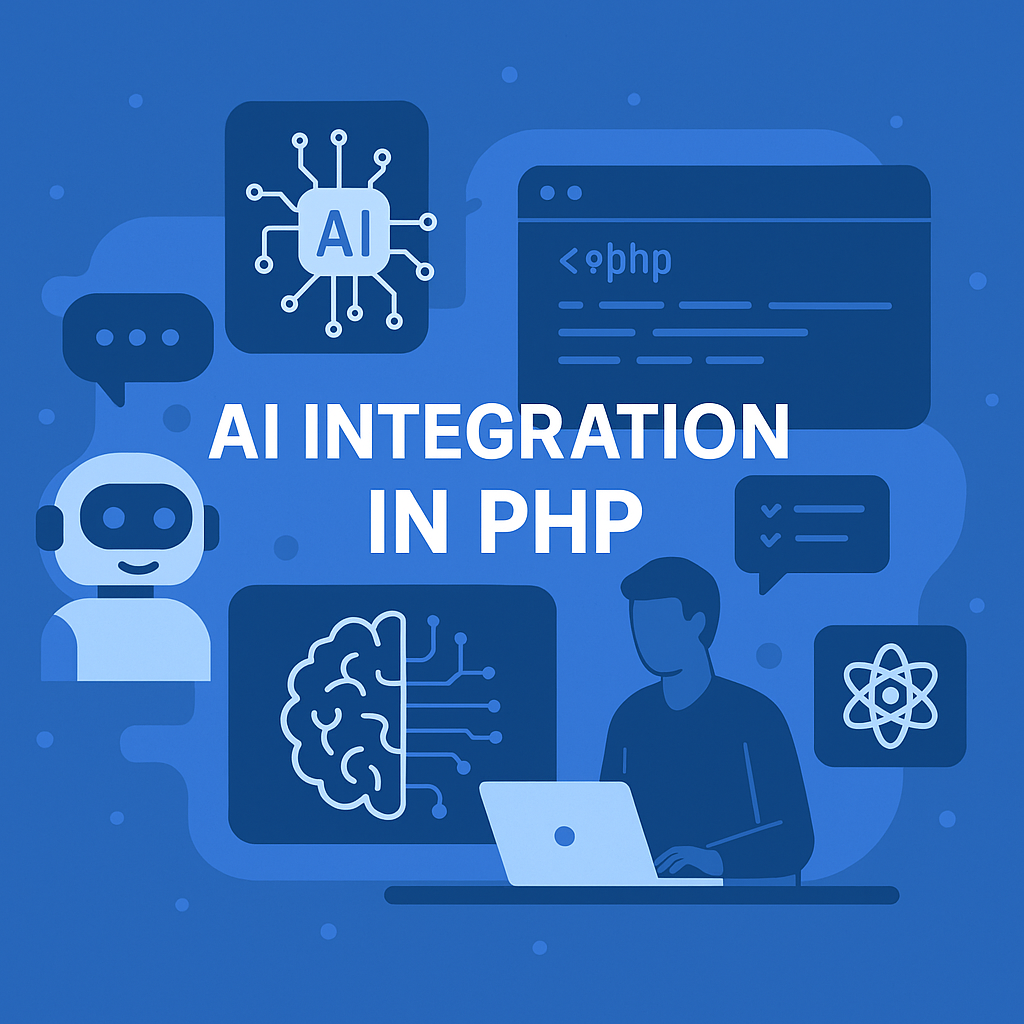
Why PHP Is Ready for AI Integration
PHP is one of the most popular languages on the web. Millions of websites and applications rely on PHP every day. But in today’s fast-moving tech world, adding AI features is becoming just as important as having a solid backend. From chatbots to smart recommendations, AI is changing how apps work. And the good news? You can integrate AI into your PHP apps—easily and powerfully.
In this article, we’ll explore how PHP developers can tap into the world of artificial intelligence. Whether you’re building a chatbot, connecting with OpenAI, or creating custom features powered by machine learning, this guide will walk you through it all—step by step.
What Does “AI Integration” Really Mean?
AI integration means adding smart behavior to your app. It’s like giving your app a brain. Instead of just showing information or storing data, your app starts understanding context, making decisions, or even talking like a human.
Some popular examples include:
- Chatbots that answer questions automatically.
- Recommendation engines that suggest products or articles.
- Text generation for blog posts or emails.
- Sentiment analysis to understand customer tone.
And all of these can now be added using tools like OpenAI’s API, directly inside your PHP application.
Why Use PHP for AI Features?
Many people think PHP is only for traditional websites. But that’s no longer true.
Here’s why PHP is great for AI:
- Easy to integrate with APIs like OpenAI or Hugging Face.
- Strong community and support.
- Works well with frontend tools like React or Vue.
- Fast deployment on popular hosting platforms.
Plus, PHP is simple to write and debug. This makes it perfect for quickly testing AI features.
Getting Started with OpenAI in PHP
Let’s begin with one of the most powerful AI tools available today—OpenAI. It powers tools like ChatGPT, DALL·E, and Codex.
Step 1: Get an OpenAI API Key
- Visit the official OpenAI website.
- Create an account and log in.
- Go to your dashboard and generate an API key.
This key will allow your PHP app to send requests to OpenAI and receive AI-generated responses.
Step 2: Install Guzzle (or Use cURL)
To make API calls in PHP, you can use Guzzle or cURL. Guzzle is easier and cleaner:
composer require guzzlehttp/guzzleStep 3: Write PHP Code to Call OpenAI
Here’s a simple example using Guzzle:
use GuzzleHttp\Client;
$client = new Client();
$response = $client->post('https://api.openai.com/v1/chat/completions', [
'headers' => [
'Authorization' => 'Bearer YOUR_API_KEY',
'Content-Type' => 'application/json',
],
'json' => [
'model' => 'gpt-3.5-turbo',
'messages' => [
['role' => 'user', 'content' => 'Tell me a joke.'],
],
],
]);
$data = json_decode($response->getBody(), true);
echo $data['choices'][0]['message']['content'];Replace YOUR_API_KEY with your real key. You can now ask OpenAI anything—right from your PHP app!
Building a Simple Chatbot with PHP and OpenAI
Let’s build a basic chatbot.
1. Create a chat form in HTML
<form method="post">
<input type="text" name="user_input" placeholder="Say something...">
<button type="submit">Send</button>
</form>2. Process the input in PHP
$userInput = $_POST['user_input'] ?? '';
if ($userInput) {
// Same API code from earlier
// Show the AI response below the form
}In just a few lines, your PHP site can now respond like a human.
Other AI Features You Can Add in PHP
There’s a lot more you can do beyond chatbots. Let’s explore:
1. Text Summarization
Want to shorten articles? Use OpenAI’s prompt:
“Summarize this article in 3 bullet points.”
2. Sentiment Analysis
Understand user mood from messages:
“Is this sentence positive or negative?”
3. Product Descriptions
Auto-generate ecommerce content:
“Write a fun product description for a wireless mouse.”
4. Code Generation
Even developers can use AI to generate snippets:
“Write a PHP function to validate an email address.”
Best Practices for Integrating AI with PHP
Using AI is exciting, but there are important tips to keep in mind.
Be Clear With Prompts
The better your question, the better the answer. Guide the AI with specific instructions.
Bad: “Tell me about cats.”
Better: “Explain why cats make good pets in 3 simple sentences.”
Handle Errors Gracefully
APIs can fail due to rate limits or network issues. Always use try…catch blocks and show fallback messages.
Store Results (When Needed)
AI calls can cost money and take time. Save results in your database if they won’t change often.
Stay Secure
Never expose your API key. Store it in environment files, not your public code.
Common Mistakes to Avoid
Let’s quickly go over pitfalls many developers hit:
- Overusing AI for simple tasks
Not everything needs AI. Use it where it adds value. - Not caching results
Every call costs time and money. Cache smartly. - Unfiltered outputs
AI responses can be unpredictable. Always sanitize outputs before showing them to users. - Ignoring user input limits
Restrict message length to avoid abuse or long delays.
Real-Life Example: Smart FAQ System
Imagine a support page. Users ask questions, and instead of showing a list of articles, your app replies with answers using OpenAI.
Benefits:
- No need to write every possible FAQ.
- The system improves by learning what users ask.
- It’s faster than live chat for common questions.
This kind of smart feature turns a basic PHP app into a user-friendly tool.
Should You Train Your Own AI Model?
While it’s possible to train custom models, it’s complex and requires large datasets.
Instead, most PHP apps work best by:
- Using pre-trained APIs like OpenAI.
- Customizing the prompt to suit your app’s voice and style.
- Storing prompts and outputs in a database for reuse or analysis.
Unless you’re building an AI-first product, this method is faster and more cost-effective.
Tools and Libraries That Help
Here are official tools and platforms to consider:
- OpenAI API
- Hugging Face Inference API
- Guzzle (HTTP Client)
- dotenv for PHP – For safely storing your API keys
These tools make it easier to connect, test, and manage your AI-powered features.
Can You Combine PHP with Frontend AI?
Yes! Many developers use PHP for backend logic and React or Vue for the frontend. You can make API calls from PHP and send responses to the frontend in JSON.
For example:
- User enters a question in a React form.
- React sends it to PHP via AJAX.
- PHP talks to OpenAI and returns the answer.
- React shows the response in chat UI.
It’s smooth, modern, and fully dynamic.
Conclusion: AI and PHP—A Perfect Match
AI is no longer just a buzzword—it’s a must-have for smart apps. And PHP is more than ready to handle it.
From chatbots to custom content generation, integrating AI in PHP is easier than ever with tools like OpenAI. With just a few lines of code, your app can learn, respond, and improve how users interact with it.
Whether you’re a solo developer or part of a large team, now is the time to explore AI in your PHP projects.
Ready to dive in? Visit the OpenAI Documentation to get started today.

